Affiliate disclosure: This post may contain affiliate links. Please see our Privacy Policy.
Walking through the forest, most people never realize how much food is growing all around them. Sure, most people know you can tap maple trees for syrup and that you can collect acorns from oak trees. But what about the others?
Birch trees are edible in a number of different ways. Birch trees can be tapped for syrup, and the nutritious sap is used medicinally in Eastern Europe.
The early spring buds are aromatic and flavorful if you can catch them before they break bud. But beyond that, the inner bark can be made into a surprisingly nutritious flour, containing 500 to 600 calories per pound of flour.
Now that I’ve tried it, I found that it tastes quite a bit like buckwheat flour, and it makes delicious cookies.
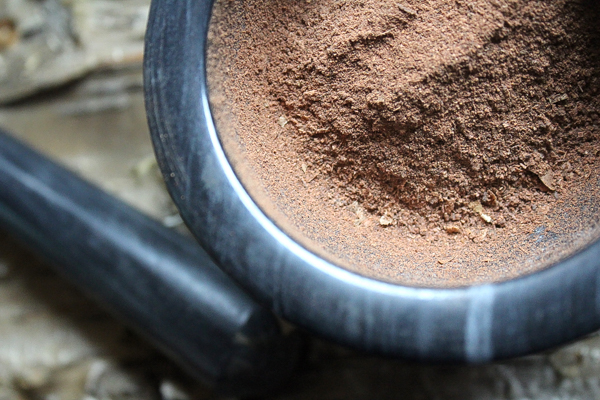
Traditional Use of Birch Bark
Birch bark flour is made by harvesting the inner bark that carries nutrients from the roots up to the leaves. The outer bark is used to make baskets and buckets, like traditional sap buckets, but the inner bark is the edible part.
Birch bark was traditionally harvested by the Sami people in Northern Sweeden. While some references say that bark bread was a survival food, there’s evidence that it was eaten even in times of plenty.
According to Nordic Food Lab, a group that researches traditional Nordic foods, “There is no indication in our records that historically well-known famine years resulted in more bark being peeled in those years.” They found that it was a staple food source in the 1600s and 1700s.
There is some evidence that eating bark flour bread was actually a sign of wealth. “It has also been pointed out that rich Sami families with many tamed reindeer and large milk production normally collected the largest quantities.” That’s because the bark was often mixed with reindeer milk to make the bread.
Even though eating bark flour bread was more connected to wealth than famine, in the 19th century, Swedish officials started a campaign to convince the people that eating bark was dangerous. “Swedish authorities generated intense propaganda against the use of bark for food, and from 1870 onwards, Swedish legislation forbade the harvesting of bark from trees growing on crown land.”
Harvesting Birch Bark Ethically
Anytime you cut into the bark of a tree, you’re opening up the trunk of the tree to insects, disease, and decay. If you cut around the full circumference of the tree, a practice known as girdling, the supply of nutrients is completely cut off, and the tree will die. So obviously, harvesting all the bark from a living tree is not ethical or sustainable, but how much is acceptable?
Some foragers stick to a 1/3 rule and say to harvest no more than 1/3 of the bark around a tree. Even that is pretty excessive.
When rodents damage apple trees in an orchard, stripping them of bark, the farmer won’t even try to bring back anything with more than 1/3 of the bark missing around the circumference. If you’re harvesting 1/3, you’re pushing the limits of that tree’s survival and crippling it for the rest of its life.
Obviously, in a survival situation, you have to do what is necessary to survive, but most of us these days are foraging recreationally and for our own education. In those cases, bark should only be removed from trees that are about to be cut or trees that have recently come down.
According to the Herbal Academy’s online Botany and Wildcrafting Course, “As a rule, never harvest from the trunk of a living tree. Only harvest bark from a tree that has been recently cut down for some other reason or has recently fallen over on its own. The timing here can be tricky, as you only want to harvest from recently fallen trees (within a few weeks of falling or being cut down) and not those that have begun to rot and decay. Never, absolutely never, cut a tree down simply just to harvest its bark or its root bark. This is not only unethical, but unsustainable, and is the reason why so many tree species used in herbalism, such as slippery elm (Ulmus rubra), are currently at risk from over-harvesting.”
The herbal academy’s course is a great resource for beginning foragers, especially if you’re not sure about best practices for ethical wildcrafting.
The particular tree I’m using was knocked down when a dead tree fell on it in a winter storm. This tree was very much alive and healthy, but natural circumstances brought it down.
That makes it the perfect candidate for wild foraged flour. I didn’t go out and strip a living tree, but I did make use of what nature provided.
How to Make Birch Bark Flour
Start by removing the outer bark. The outer papery birch bark is used to make baskets and containers, and hipsters are using it to decorate their upscale apartments these days. Keep it for another craft project, or fancy up your living room.
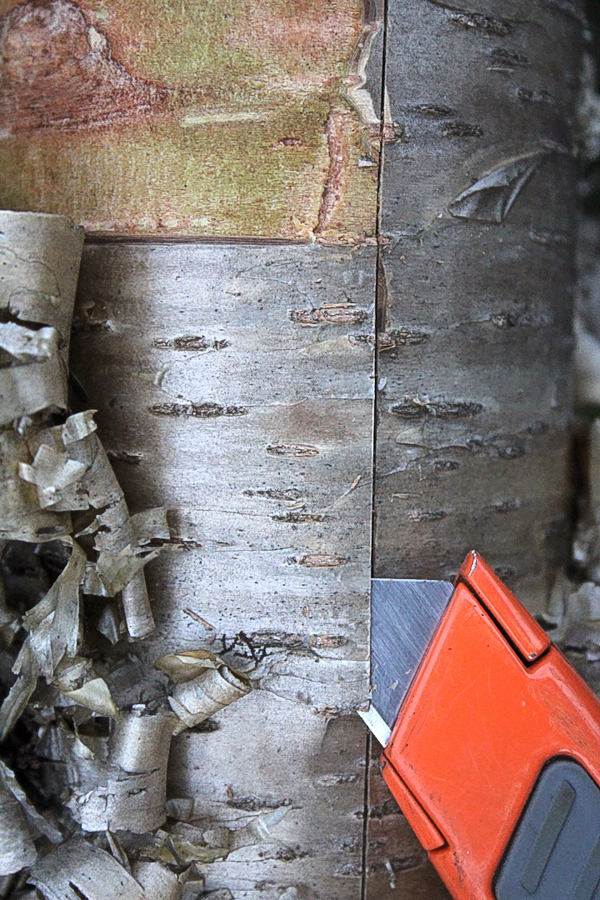
I used a box knife to score the outer birch bark and then slipped it under to separate the layers.
Once I got it started, it peeled back easily with my hand.

The inner bark is what the tree uses to transport nutrients from the soil to the leaves.
It’s actually a little bit thicker than the papery thin outer bark, which you can see from the end of this limb.
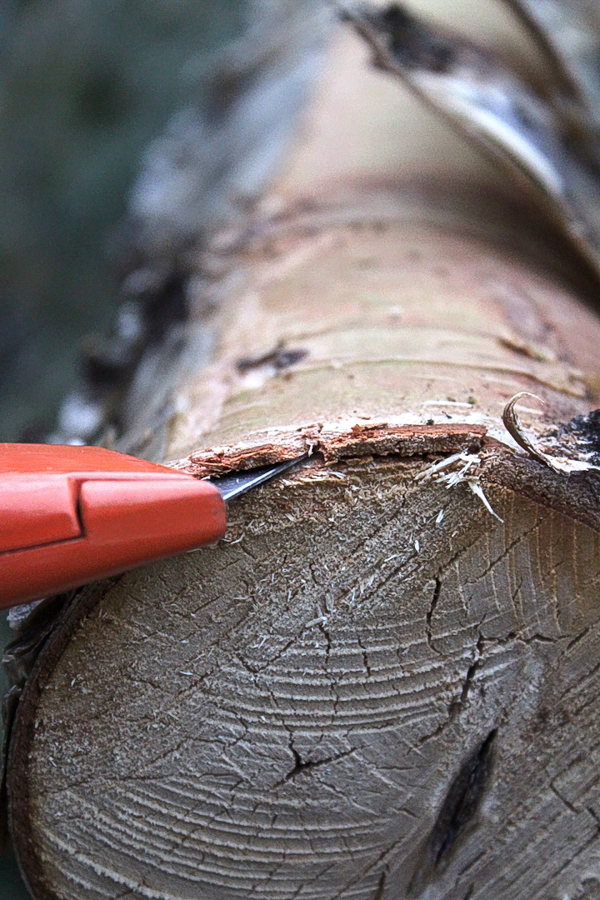
Traditionally birch bark is harvested in sections from a living tree, many of ours are small and we’re saving them all for birch syrup. This tree was knocked down when a dead tree fell on it in a winter storm, and it was a few weeks before the weather cleared and snow melted back and I could access it. The inner bark is already a bit dry and didn’t peel off in sheets like I thought it would.
Perhaps that’s the case with a fresh birch, but I can’t say. Nonetheless, I had a lot of trouble peeling the inner bark with a box knife.
I quickly switched to a draw knife and had much better results. It’s tricky to peel just the outer bark, without going into the wood, but with a bit of practice, I got it.
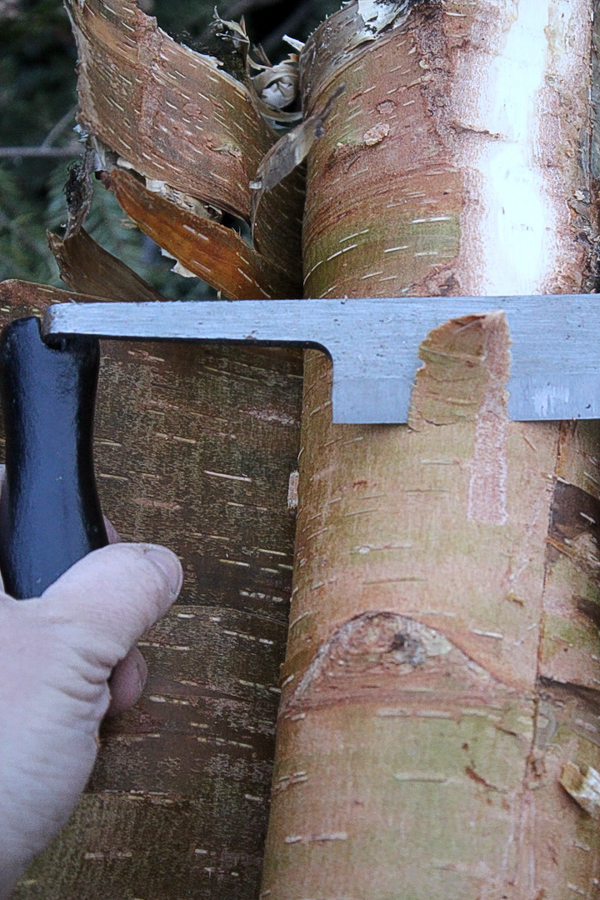
Using a draw knife, the inner bark came off in thin curls, and it was already pretty dry.
Likely due to the age of the tree. It had a pleasant, wintergreen scent that filled the air anytime I touched it.
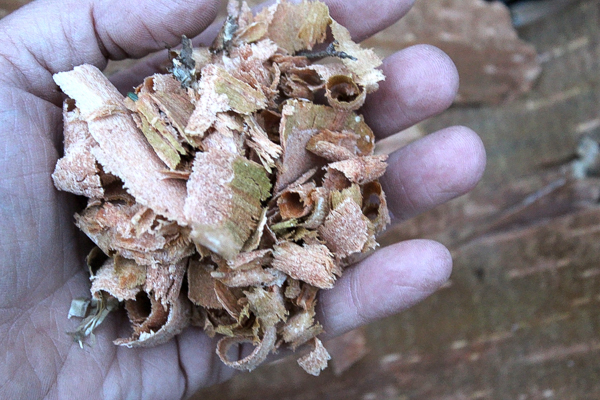
Once you separate the inner bark from the tree, dry it either in the sun, in a dehydrator or near the wood stove. I dried this birch bark in the oven at 250 degrees for 30 minutes.
Once dried, the birch bark is ground into flour. I started with a food processor and after about a minute on high, the bark was mostly flour, with some larger chunks. I transferred the mixture to a stone mortar and pestle and finished grinding up the last bits.
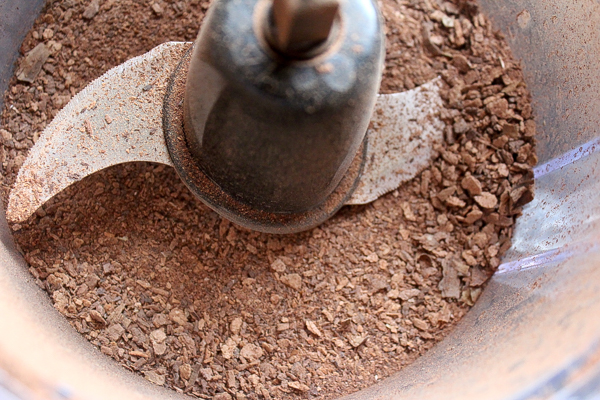
How to Use Birch Bark Flour
Using birch bark flour can be a bit tricky.
Yeast cant digest the nutrients in bark flour as readily as they can in wheat flour, and the bread will have trouble rising if there’s too much bark flour. Birch bark flour also doesn’t hold together well in baked goods, so it’s often incorporated in small amounts for flavor and nutrition.
Don’t substitute more than 1/4 to 1/3 bark flour in the total recipe.
Beyond the texture concerns, birch bark flour also has a slightly bitter taste, that is best used in small amounts. Though the raw flour had a strong wintergreen scent, I didn’t taste any wintergreen flavor in the finished baked goods.
The bitterness was very mild, and in a blind taste test, I’m not sure I could tell the difference between birch bark flour and buckwheat flour.
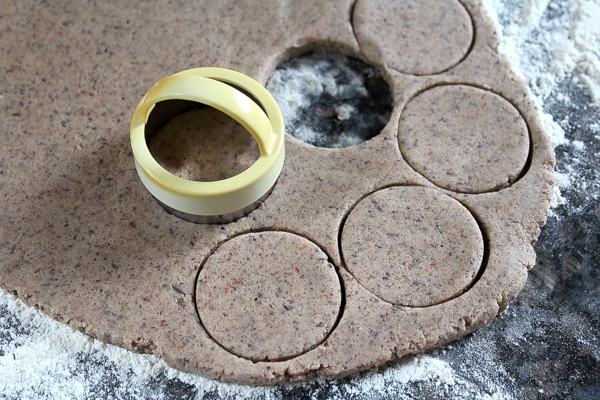
Since birch bark bread doesn’t rise well, I decided to use the flour to make birch bark shortbread cookies. Shortbread cookies often have a bit of rice flour incorporated to give them a crumbly texture, since rice flour doesn’t bind like wheat flour.
Rice flour usually makes up about 1/4 of the total flour in the mixture, which made for an easy birch bark flour substitution.
I found that birch bark flour gave the same result, along with a pleasant earthy flavor.
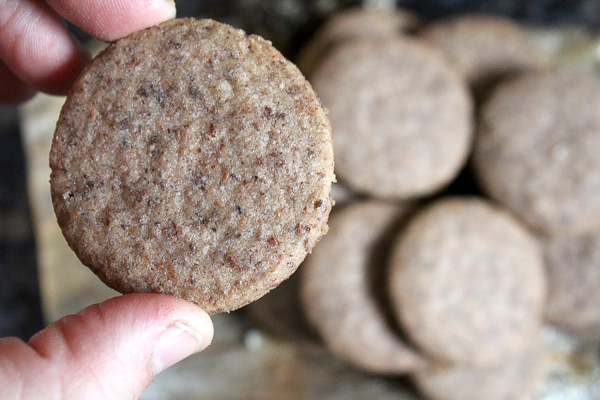
The final cookies, believe it or not, are absolutely delicious My 3-year old loved them, and actually preferred them to the strawberry banana bread I made that same afternoon, and my baby girl loves banana bread.
They’re crisp and earthy, with just enough sweetness.
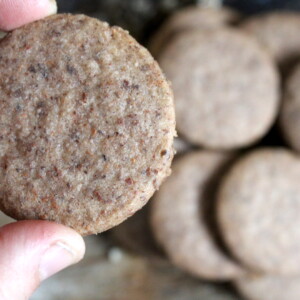
Birch Bark Shortbread Cookies
Ingredients
- 3/4 cup white flour
- 1/4 cup birch bark flour
- 1/4 cup sugar
- 1 pinch sea salt
- 1/2 cup butter, softened
Instructions
- Mix the white flour, birch bark flour, sugar and salt together.
- Use a hand mixer to blend in the butter until it’s fully incorporated.
- Give the mixture a few quick kneads until it comes together.
- Roll out the cookie dough on a floured surface, and cut out cookies.
- Bake for about 15 minutes at 350 degrees.
Nutrition
Nutrition information is automatically calculated, so should only be used as an approximation.
Wild Foraged Recipes
Looking for more wild foraged recipes?
- Pine Bark Cookies
- Pine Bark Bread
- 40+ Wild Plants You Can Make Into Flour
- 100% Wild Foraged Cookies
- Chanterelle Ice Cream
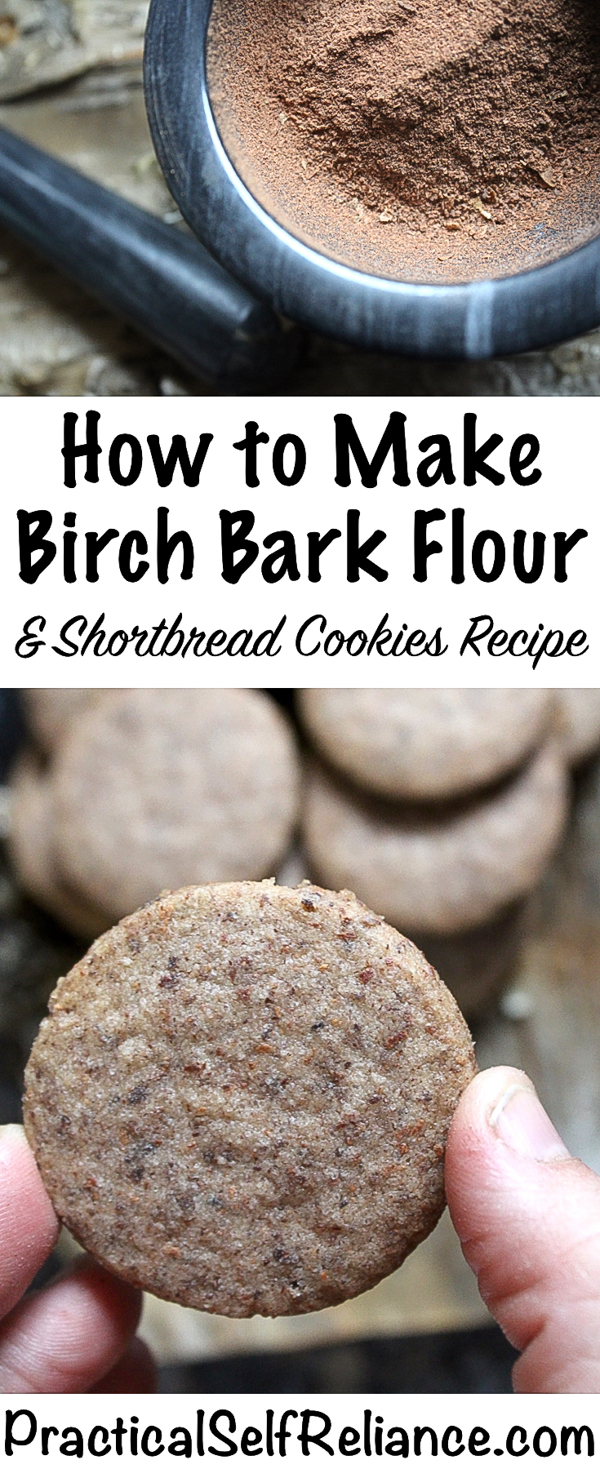




This sounds interesting. Am wondering how it would incorporate in gluten-free recipes. Would like to give it a try if we are able to harvest bark. I live in an area where white is pretty prolific but yellow is readily available in some areas. Did you use bark from white birch or yellow?
This is yellow birch. As to gluten free recipes, you could add a bit to a 1 to 1 gluten free flour mix.
Hey I know this is off topic but I was wondering if you knew of
any widgets I could add to my blog that
automatically tweet my newest twitter updates.
I’ve been looking for a plug-in like this for quite
some time and was hoping maybe you would have some experience with something like
this. Please let me know if you run into anything.
I truly enjoy reading your blog and I look forward to your new updates.
Hey I know this is off topic but I was wondering if you knew of
any widgets I could add to my blog that
automatically tweet my newest twitter updates.
I’ve been looking for a plug-in like this for quite
some time and was hoping maybe you would have some experience with something like
this. Please let me know if you run into anything.
I truly enjoy reading your blog and I look forward to your new updates.
Birch trees can be coppiced, a practice common in Europe where they are cut down to the base every 4-6 years. The tree grows back around the stump; creating sustainable resources. Hazel, willow, popular, and many others were done in this fashion. This method allows for birch trees to exist almost infinitely; connecting them to the Birch rune which symbolized rebirth and renewal. The wood can then be used for flour, basketry, heating, lumber, ect.
Thank you for this article.
You’re very welcome. Thank you for sharing.
Ashley,
Do you make black walnut syrup? I heard that it has many health benefits.
You live in Vermont if I remember correctly.
Donna
We don’t have any tappable black walnut trees on our land, but my
friend Teri at Homestead Honey makes black walnut syrup. It’s quite
tasty, but I don’t know about the medicinal benefits in syrup or any
kind. Here’s here discussion of it:
https://homestead-honey.com/beyond-maple-syrup-tapping-black-walnut-trees/
I have a question. I gathered acorns for the last 2 autumns. They have been outside on our covered porch ever since. Can I use these to make acorn flour? TY
As long as they are dry and in their shell, I would think that they would still be ok.
I love this whole bit of info. Is there a way of saving it to print? I’m having issues.
I love this whole bit of info. Is there a way of saving it to print? I’m having issues.
I love this whole bit of info. Is there a way of saving it to print? I’m having issues.
I’m hopefully coming up with a way to do that in the next few months, I get asked for printable versions a lot!
what size/diameter tree were you using and how thick was the inner bark? seems to me one might want to use only half of the inner bark—that which lies closest to the cambium—i think that is the most functional part of the inner bar and not the outer half. i used the thick bark and it worked. but what about trying the 2-5 inch diameter trees? they have a thinner bark layer and it is much more flexible and peels easier from the tree. one could thin out the trees from a denser area of the forest. i really appreciated your write up and recipe—i baked several batches and they turned out just fine Thanks. john zasda
The tree I was using for this article was 4-5 inches in diameter I believe.
Where I live, people stripping birch bark from living trees is a real problem. They don’t know what damage it does, and it ends up killing the tree. I hope people only use trees on their own property, that are being cut down anyway. The Wildlife refuge near where I live is seeing birch trees killed because of people stripping the bark.
I tap birch trees for sap to make syrup in northern Michigan and have made presentations to community groups about the process. The sap begins to flow just as maple sap quits running. Birch sap stops running when the tree limbs buds develop. It’s generally a 3 week sap season for birch trees here.
I tap birch trees for sap to make syrup in northern Michigan and have made presentations to community groups about the process. The sap begins to flow just as maple sap quits running. Birch sap stops running when the tree limbs buds develop. It’s generally a 3 week sap season for birch trees here.
If I were to make birch bark cookies, I would use my baker’ ammonia for a rapid strong level that would be clear flavored in a product so thin. Prior to your blog post, the only reference that I had for using birch flour was an old Russian woman who came often to the bakery where I worked, She said that real Russian Rye was made with 15% birch flour, 25% rye and the rest wheat flour. I thought that she ment finely ground sawdust. It’s good to know that there was more to the story. Directly under the paper bark birch there is a thick brown punky layer that gets very crumbly. I can see how this layer would lend itself to harvest. In Alaska harvesting large sheets of birch bark from living trees is common. If the inner bark is undisturbed, the free continues to grow rather well. I personally would not make such a harvest, but I do cut my own firewood and would have no trouble at collecting as much bark from fresh trees in the spring just prior to budding.
Leavening not level, ammonia (pure crystals for baking) is amazing at making light tender shortbread cookies. My pecan short reads are always a favorite at cookie exchanges.
I see you used white birch. Do all varieties of birch have edible inner bark? I have a river birch nearby, which has outer bark that peels off naturally as part of the growth cycle.
The part that peels off on all birch varieties is the “outer” bark that is great for crafts, basketry and even flavoring birch beer, but it’s not the inner bark that’s referred to in this recipe. To take this bark, you’ll have to damage the tree substantially, and it should only be done with a tree that’s going to be cut anyway.
The tree I’m using is a yellow birch, but to the best of my knowledge, all birch species will work for this.
I bet this would make excellent crepes!
Ooo! Great idea!
I love that you explained the ethics of using the bark. I started out thinking “Yeah, but…” so I pretty happy when I read on. A lot of people don’t realize the impact of what they do to trees.
If you boiled the bark before drying, would that reduce the bitterness? This works in making acorn flour.
Ashley: Have you tried Birch Bark Tea, cut the bark into strips an place in a pot with water and boil. add sweetener and enjoy.
I haven’t actually. I keep hearing the same thing for birch twig tea too. We just had a small paper birch come down on our land, so maybe it’s time I finally try this =)
What is the best time of year to harvest birch bark for flour?
Late spring and early summer, the sap runs at that time will ensure that the inner bark contains the most nutrition. It’s also easier to peel away when it’s wet and fresh with the spring sap run. That said, you can harvest it at any time that the tree is not frozen/dormant.
I tap birch trees for sap to make syrup in northern Michigan and have made presentations to community groups about the process. The sap begins to flow just as maple sap quits running. Birch sap stops running when the tree limbs buds develop. It’s generally a 3 week sap season for birch trees here.